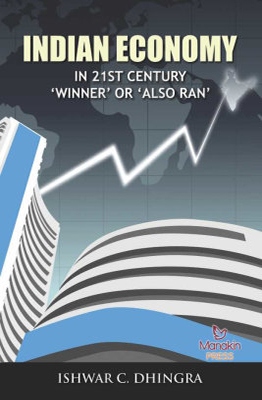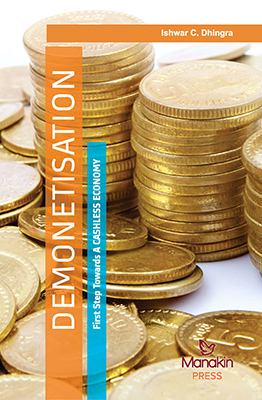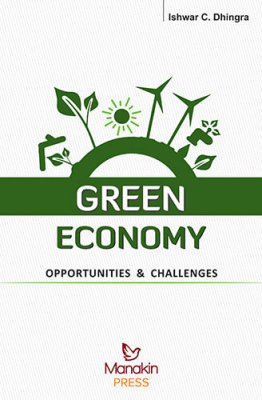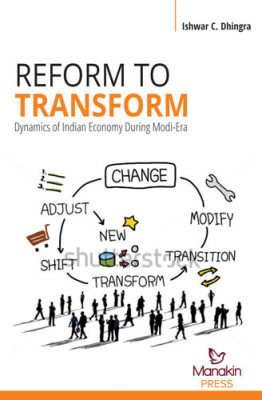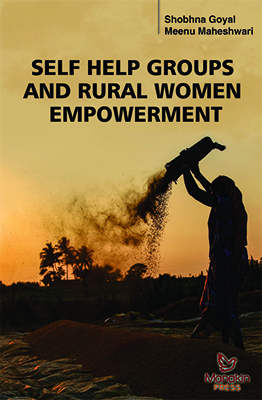Indian Economy in The 21st Century ‘Winner’ or “Also Ran”
₹1,895.00
Ishwar C Dhingra | Category: Economics
Binding Type: Hard Binding
Book Details
ISBN: 9789386221629
YOP: 2018
Pages: 954
Order also on
Indian economy is on the move. Beginning in early 1990s the economy moved swiftly riding piggy back on the new growth paradigm of globalisation and liberalisation. Globally, free markets were fast engulfing the economy and were creating a new world order in which every individual country was supposed to be a “winner”. The simple philosophy of growth was: create, generate and nurture production enterprises and aid them to acquire global competitiveness. Let the old, tired, exhausted, inefficient, low productive units be weeded out by market forces. Let the efficient world economy provide new work station for those who have fire in tummy. India was the forerunner among emerging economies that got pegged to this philosophy and enjoyed the fruits of “Consumption led growth”
after bearing initial hiccups, India emerged as the front runner and reached the high growth trajectory. For the first time in history India enjoyed the fruits of the economy that was growing at an annual average rate of 8% and above. However, as has happened many times in the past the global economy lost its moorings by the close of the first decade of the new century. But, wonder of wonders India could survive the global mayhem and held steadfast to its position. This was made possible, largely, by the institutional – structural transformation that India has undergone in more recent times. Will India keep its march and
emerge as the “driver” of the global economy, or would the engine fritter away its steam and get added to the long list of “also ran”. This theme has been exhaustively dissected in this book.
1. Measurement of Economic Development
2. Evolution of Indian Economy
3. Poverty in India
4. Natural Resources
5. Infrastructure (Transport, Communication and Energy)
6. Profile of Human Resources
7. National Income and Capital Formation
8. Distribution of Income and Balanced Regional Development
9. Employment and Unemployment
10. Inflation and Growth in India
11. Agriculture and Economic Development
12. Technological Changes in Agriculture: Agricultural Inputs
13. Land Reforms in India and Agricultural Labour
14. Provision of Non-Farm Services: Agricultural Finance and Marketing
15. Food Security and Agriculture Price Policy
16. Rural Development, Co-operation and Panchayati Raj
17. Industrial Development and Policy
18. Public Enterprises and Privatisation
19. Micro, Small and Medium Enterprises
20. Foreign Trade of India and Balance of Payments
21. Foreign Capital and Multinational Corporations in India
22. Financial System in India
23. Reserve Bank and Monetary Regulation in India
24. Fiscal System in India
25. Postscript
Indian economy is on the move. Beginning in early 1990s the economy moved swiftly riding piggy back on the new growth paradigm of globalisation and liberalisation. Globally, free markets were fast engulfing the economy and were creating a new world order in which every individual country was supposed to be a “winner”. The simple philosophy of growth was: create, generate and nurture production enterprises and aid them to acquire global competitiveness. Let the old, tired, exhausted, inefficient, low productive units be weeded out by market forces. Let the efficient world economy provide new work station for those who have fire in tummy. India was the forerunner among emerging economies that got pegged to this philosophy and enjoyed the fruits of “Consumption led growth”
after bearing initial hiccups, India emerged as the front runner and reached the high growth trajectory. For the first time in history India enjoyed the fruits of the economy that was growing at an annual average rate of 8% and above. However, as has happened many times in the past the global economy lost its moorings by the close of the first decade of the new century. But, wonder of wonders India could survive the global mayhem and held steadfast to its position. This was made possible, largely, by the institutional – structural transformation that India has undergone in more recent times. Will India keep its march and
emerge as the “driver” of the global economy, or would the engine fritter away its steam and get added to the long list of “also ran”. This theme has been exhaustively dissected in this book.
1. Measurement of Economic Development
2. Evolution of Indian Economy
3. Poverty in India
4. Natural Resources
5. Infrastructure (Transport, Communication and Energy)
6. Profile of Human Resources
7. National Income and Capital Formation
8. Distribution of Income and Balanced Regional Development
9. Employment and Unemployment
10. Inflation and Growth in India
11. Agriculture and Economic Development
12. Technological Changes in Agriculture: Agricultural Inputs
13. Land Reforms in India and Agricultural Labour
14. Provision of Non-Farm Services: Agricultural Finance and Marketing
15. Food Security and Agriculture Price Policy
16. Rural Development, Co-operation and Panchayati Raj
17. Industrial Development and Policy
18. Public Enterprises and Privatisation
19. Micro, Small and Medium Enterprises
20. Foreign Trade of India and Balance of Payments
21. Foreign Capital and Multinational Corporations in India
22. Financial System in India
23. Reserve Bank and Monetary Regulation in India
24. Fiscal System in India
25. Postscript
| Weight | 1.62 kg |
|---|---|
| Dimensions | 24.2 × 16.3 × 5.2 cm |
| yop |
2018 |
| subject-category |
Economics |
| isbn |
9789386221629 |

